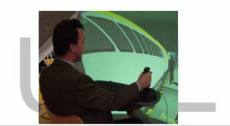index
Virtual Discontinuities
click on images for full-size:

Driver and disaster training through virtual reality

Interacting with a computer to design a spherical object
Exploring a temple in a virtual reality cave at Iowa State University -- image reproduced courtesy of Whitney Sanford
A discontinuous
virtual place might involve linked areas with wildly varying textures and geometries. It would be possible to set up virtual places that involve jumps between separate virtual realities. For instance a room in a virtual world might contain a "portal" to a different virtual world, and the regions around both sides of that door could belong to one single place in terms of actions, perhaps the office of some Virtual Universe Oversight Committee. This office could include unified trajectories of action across discontinuities where portions of separate virtual worlds come together as parts of the same place. The place would be unified, yet not cut out of some common spatial continuum. When you walked into the part of that office in the other virtual world, you would not cross some intervening neutral space, and aside from the office door the two virtual worlds might have no connections. They also might have very different internal geometries and "physical" laws. This kind of whole,
discontinuous yet immediately adjacent and unified in and for some actions, might spatially prefigure some kinds of cultural unities that seem to be developing.
While such an oddly linked place would be different from what we are used to, the flexible spatiality of virtual worlds tempers the effect of such discontinuities. In today's MOOs you can hike laboriously about in the virtual space discovering new locations, but the MOO software also provides a "teleport" command to take you instantly to already discovered places. In a similarly equipped virtual world, if a place were made from linked sub-regions that were widely scattered about the landscape of the larger virtual world, or even in several disjoint virtual worlds, the possibility of immediate jumps among the sub-places would make inhabiting such a place like
moving from one room to another in a large building, such as a hotel with differently styled rooms. Even though the sub-regions were widely dispersed they would become adjacent in the experienced geometry of the place. The place as a whole would be
experienced as continuous, though its textures and internal geometries might be very different from region to region.
- [Nearby: Discontinuous places -- Social creation ]


